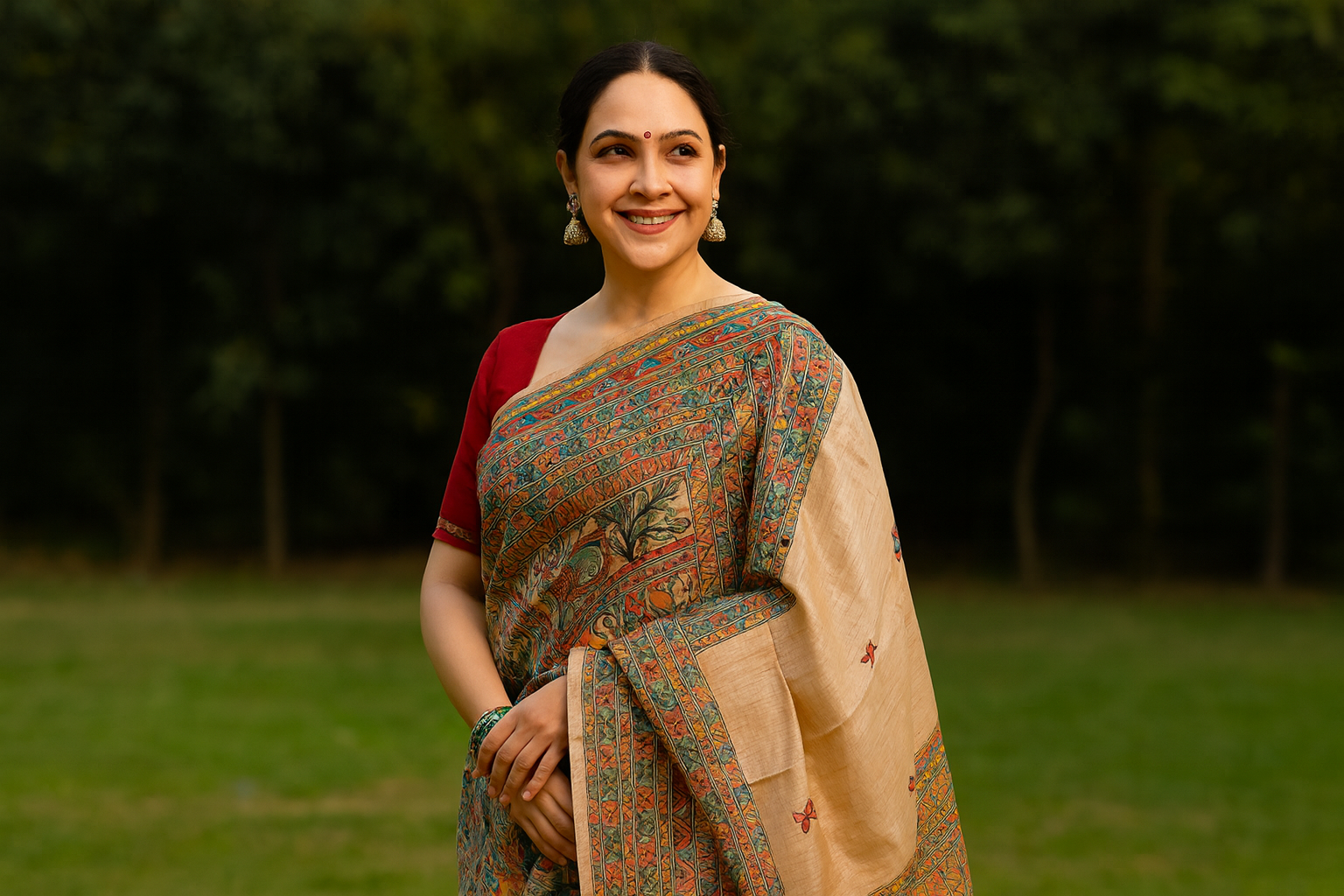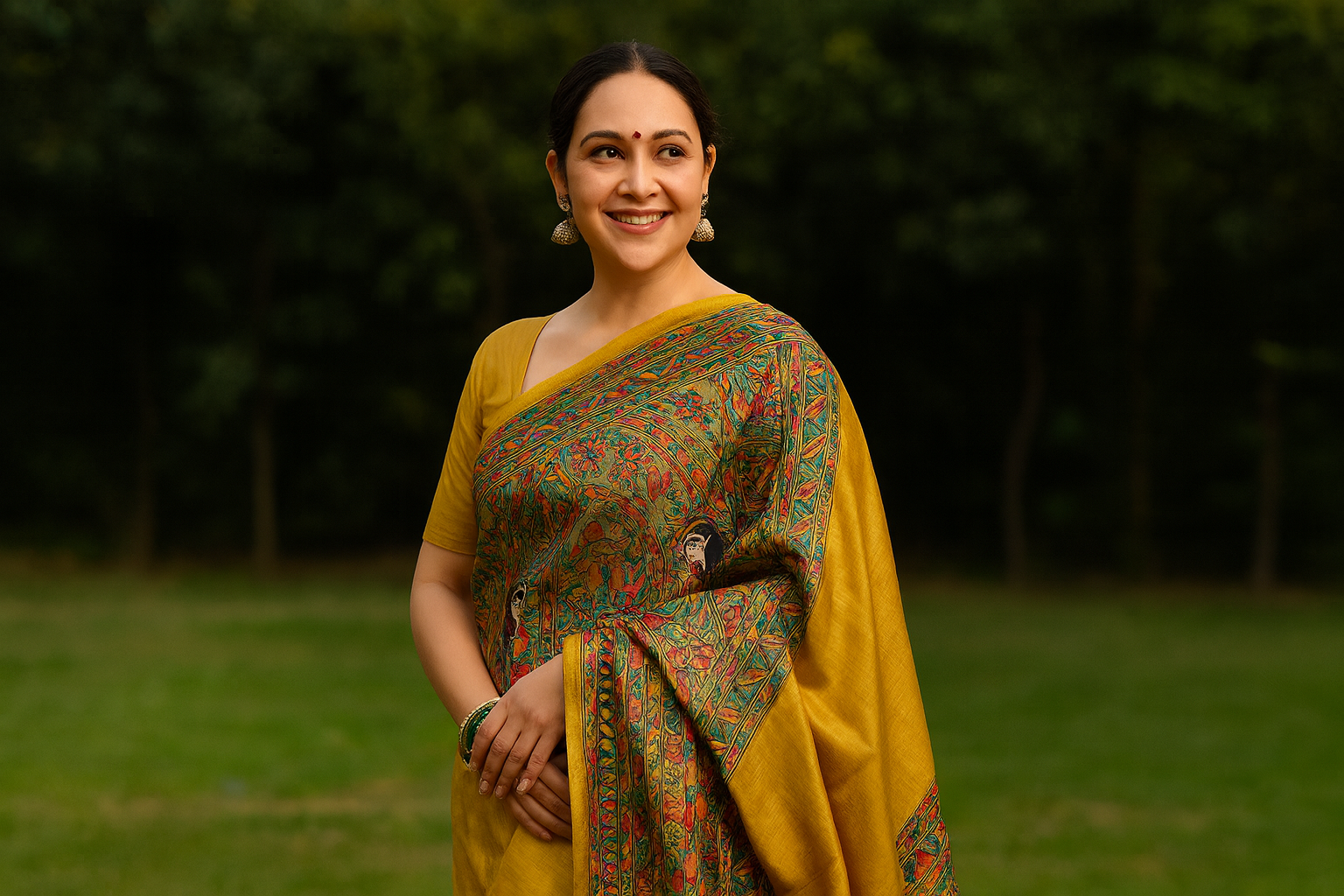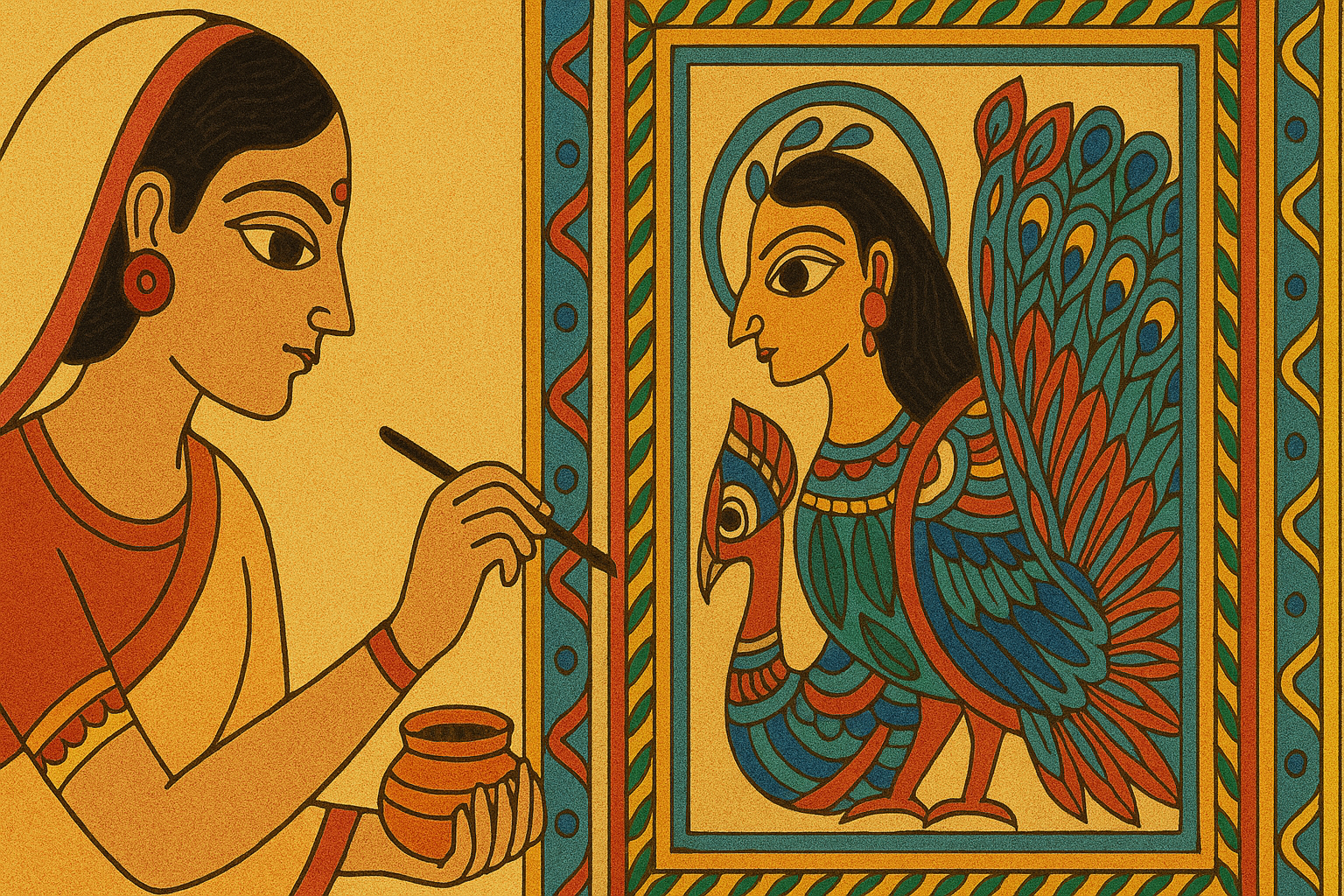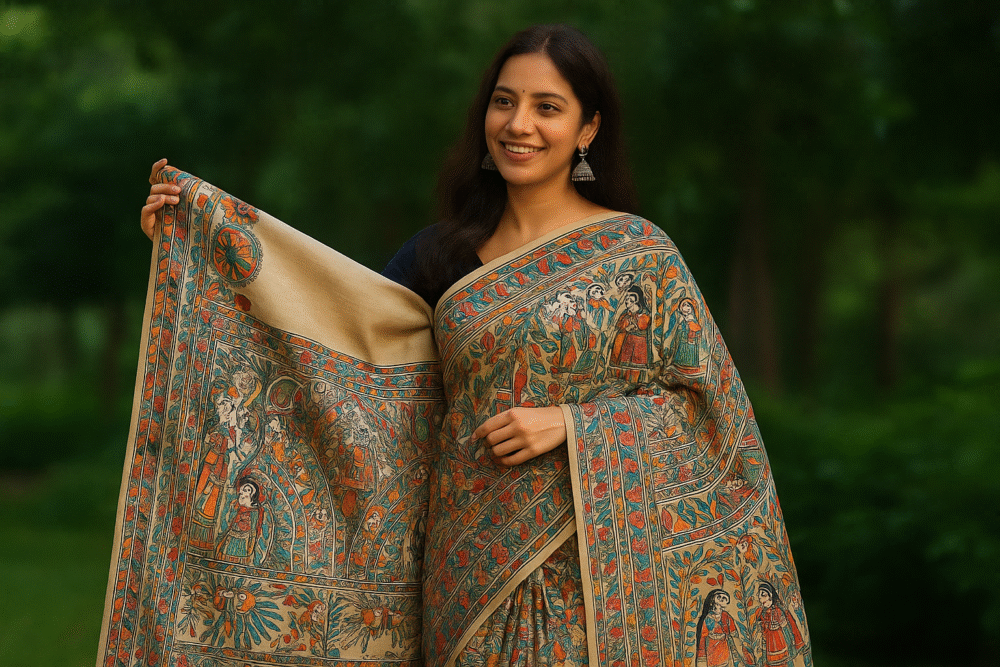The Madhubani designs painting, also referred to as Mithila paintings, is a revered piece of India’s rich cultural heritage....
Bring Heritage Home
Tradition Meets Art
Featured Products
Discover the World of Madhubani
Explore authentic Madhubani paintings—Bharni, Katchni, Tantrik, Godna, Kohbar—crafted with bold lines, natural pigments & rich motifs from the Mithila region.
Story About Mithila Painting
Step into the world of timeless artistry with Madhubani paintings, a traditional folk art form from the heart of Bihar.
Known for their bold lines, natural colors, and intricate detailing, these paintings beautifully capture tales of love, nature, and mythology. Each stroke is more than decoration—it’s a story passed down through generations.

Celebrate your moments with the charm of Madhubani. From weddings to anniversaries, bring home a canvas that transforms personal emotions into eternal art.
Every motif—be it a blooming lotus, a dancing peacock, or the divine union of Radha-Krishna—becomes a reflection of your journey.


✨ Discover Your Style with the Spirit of Mithila – Madhubani Sale! ✨
Sample Title
Days
Hrs
Mins
Secs
View & Purchase
Authentic Mithila Art
Eco-Friendly Colors
Worldwide Shipping
Custom Designs
Secure Payments

What Our Customers Say About Us

Rohit Sharma
Karina Chopara
Noah
Sandarac
Jerome
Our Latest Update
Mollis aliquam ut porttitor leo a. Et molestie ac feugiat sed lectus vestibulum. Tellus pellentesque eu tincidunt tortor aliquam nulla facilisi cras. Congue quisque egestas diam in arcu cursus euismod. et sollicitudin ac orci phasellus egestas.
History of Madhubani Painting – The Legacy of Mithila Painting in India
Madhubani painting, also known as Mithila painting, is not only a form of traditional Indian art but also a living testament to the country’s rich cultural heritage. Based on centuries-old traditions, this unique style of painting has captured the attention of all with its intricate patterns, vibrant colours, and powerful storytelling. Over the years, it has evolved from a sacred art practised in the homes of village dwellers to an internationally recognised style of visual expression, while maintaining its originality and appeal.
Origins of Mithila Art
The roots of Madhubani art are deeply interwoven with the cultural heritage of the Mithila region of Bihar. Indian State of Bihar. Legend tells us that King Janak of Mithila requested art enthusiasts to decorate the city in celebration of his daughter Sita’s wedding to Lord Rama, as described in the epic poem Ramayana. This is among the first sources of mythology for Mithila folk art paintings.
Historically, the women of Mithila have played a significant role in the practice of Madhubani art. They would adorn their courtyards and walls with intricate motifs for celebrations, weddings, and other religious events. These Madhubani paintings were not just decorations; they were prayers, expressions of devotion, and a means to preserve stories through generations.
Materials and Traditional Practices
The distinctive feature of traditional Madhubani painting is the handcrafted techniques used. The artists used natural materials, such as bamboo nibs, twigs, or even their fingers, to create intricate lines. Colours were drawn from natural sources, such as turmeric for yellow and white, rice paste for black, and flowers for red. Each piece was the perfect example of hand-made Madhubani art.
Walls adorned with cow dung or mud served as canvases for these artworks, which reflected themes of prosperity, fertility, mythology, and the natural world. Religious themes, such as Radha-Krishna and Shiva-Parvati, as well as the symbol of the moon and sun, were prominently featured. In a typical composition, every inch was covered with designs, leaving no space unexplored.
Styles of Mithila Folk Painting
As time passed, new kinds of Mithila folk painting developed across different communities:
Bharni (filled colours) Colours of bright hues and themes of religion, mainly used predominantly in the form of Brahmin or Kayastha women.
Kachni (line work) Fine detailing using monochrome and dual colours.
Godna (tattoo-inspired lines). Simple designs, usually in earthy hues.
Tantrik (ritual themes), Icons of religion and esoteric symbolism.
These variations added to the variety of Mithila traditional painting, but the core concept remained constant: storytelling through symbolic imagery.
Rediscovery in the Modern Era
Despite being a centuries-old practice, Mithila art remained confined to its region throughout the twentieth century. The year 1934 marked a significant turning point when a massive earthquake in Bihar unearthed the treasures of Madhubani wall paintings from the cracked mud homes. This discovery not only exposed the beauty of Madhubani painting on paper and canvas but also inspired various cultural organisations to support local livelihoods during economic hardships. The resilience and adaptability of Madhubani artists in transforming a sacred practice into a means of livelihood are genuinely inspiring.
In the 1960s, programs were initiated to transform the sacred practice of Madhubani art into a means of livelihood. Women began hand-painting Mithila artwork on canvas and paper, which could be sold outside of the region. This was a turning point in both the commercialisation and preservation of this unique art form.
Recognition of Madhubani Artists
The growing popularity of Mithila painting has led to many skilled Mithila painting artists from India receiving national and international recognition. Artists such as Jagdamba Devi, Sita Devi, and Ganga Devi became torchbearers for this art form and were awarded prestigious honours, including the Padma Shri. Their work travelled the world to showcase the power of women’s creative talents in rural areas.
Recognition not only saved the culture but also enabled women to earn a living. It transformed Madhubani painting from a local practice into a prestigious art form that is now an integral part of Indian traditional art.
Madhubani Art in the Contemporary World
Nowadays, Mithila painting designs are not just limited to walls or paper. Designers and artists are exploring new media and incorporating traditional art into clothing, fabrics, ceramics, and household furniture. From sarees adorned with Mithila paintings on canvas to accessories, bags, and even smartphone cases, the attraction to this style of art can be all-encompassing.
The increasing popularity of Madhubani painting for decorating homes is particularly noteworthy. A piece of art that is framed can add an element of culture to your living spaces, and murals and wall decor add a modern touch to your home. With a single mouse click, you can purchase Madhubani art online or browse artisanal collectives offering authentic Mithila artworks for decorating your home.
Symbolism and Spiritual Meaning
The heart of Madhubani paintings lies in their symbolism. Common motifs include:
The Sun and the Moon symbolise the celestial order and time.
Peacocks and Fish are symbols of prosperity, fertility, and harmony.
Sacred plants, like the tulsi, are thought to be auspicious.
These symbols are what make Mithila murals more than mere decoration. They are a reflection of the beliefs and collective consciousness of a group that cherished nature, divinity and human connection.
Global Recognition of Madhubani Painting
Madhubani art has transcended borders and gained recognition in museums and exhibitions worldwide. Countries such as Japan, the U.S., and France are home to an ongoing collection of hand-painted Mithila art.
Modern projects, such as the painting of entire train stations or public areas with Mithila folk art, have not only attracted tourists but also restored pride among the local community. This global recognition is a testament to the rich cultural heritage and artistic prowess of Madhubani artists, making us all proud of our cultural heritage.
These initiatives also highlight the adaptability and relevance of Madhubani’s paintings on canvas in addressing contemporary issues. Artists have utilised the traditional motifs and styles of Madhubani art to create powerful visual narratives that address modern-day concerns, thereby making this conventional art form more relatable and impactful.
Frequently Asked Questions (FAQs) about Madhubani Painting & Mithila Painting
1. What is Madhubani painting?
Madhubani painting, also known as Mithila painting, is a vibrant and culturally rich traditional Indian folk art form from Bihar’s Mithila region. It is renowned for its bold lines, natural colours, and intricate patterns that depict mythology, nature, and everyday life. Initially created on walls and floors, Madhubani paintings can now be found on canvas, paper, and even fabrics, bringing the rich cultural heritage of India to life.
2. What is the difference between Madhubani painting and Mithila painting?
There is no difference – both terms refer to the same art form. “Mithila painting” originates from the cultural region of Mithila, while “Madhubani painting” derives its name from the Madhubani district, where the style is most prevalent. Together, they represent one of the most treasured forms of Mithila folk painting.
3. What materials are used in traditional Madhubani painting?
Traditional Madhubani painting utilises natural materials, including twigs, bamboo nibs, fingers, and cotton rags, for drawing. Colours are made from natural sources, such as turmeric, flowers, soot, and rice paste. This makes every piece of handcrafted Madhubani art unique and eco-friendly.
4. What are the main themes of Mithila art?
Mithila art often features gods and goddesses, scenes from the Ramayana and Mahabharata, sacred plants, animals, and symbols of fertility and prosperity. A Mithila traditional painting never leaves blank space – every area is filled with detailed motifs.
5. Where can I buy Madhubani paintings online?
You can easily buy Madhubani paintings here from artisan collectives, craft platforms, and independent sellers. This ensures you get authentic hand-painted Mithila art while also supporting local Mithila painting artists in India.
6. Can Madhubani paintings be used for home décor?
Yes! Madhubani painting for home décor is very popular today. Whether framed as wall art, used in murals, or incorporated into fabrics like cushion covers and sarees, these paintings add cultural richness and colour to any modern living space.
7. What are the different styles of Mithila painting designs?
Some famous Mithila painting designs include Bharni (colour-filled motifs), Kachni (fine line work), Godna (tattoo-inspired patterns), and Tantrik (spiritual symbols). Each style adds a unique charm to Mithila folk art painting.
8. Are Mithila paintings available on canvas?
Yes, many artists create Mithila paintings on canvas to make the artwork more durable and suitable for framing. This adaptation has made Mithila painting for home décor more accessible for modern buyers and collectors, ensuring that your investment in this art form is long-lasting and worthwhile.
9. Who are some famous Mithila painting artists in India?
Renowned Mithila painting artists in India include Jagdamba Devi, Sita Devi, Ganga Devi, and Baua Devi, all of whom helped bring Mithila folk painting to global recognition. Their legacy continues to inspire new generations of artists today.
10. Why should I invest in Madhubani art?
Investing in Madhubani art means owning a piece of living heritage. Each hand-painted Mithila art carries centuries of tradition, cultural symbolism, and spiritual meaning. It’s not only beautiful but also a way to support rural artisans and keep this timeless Indian folk art alive.



